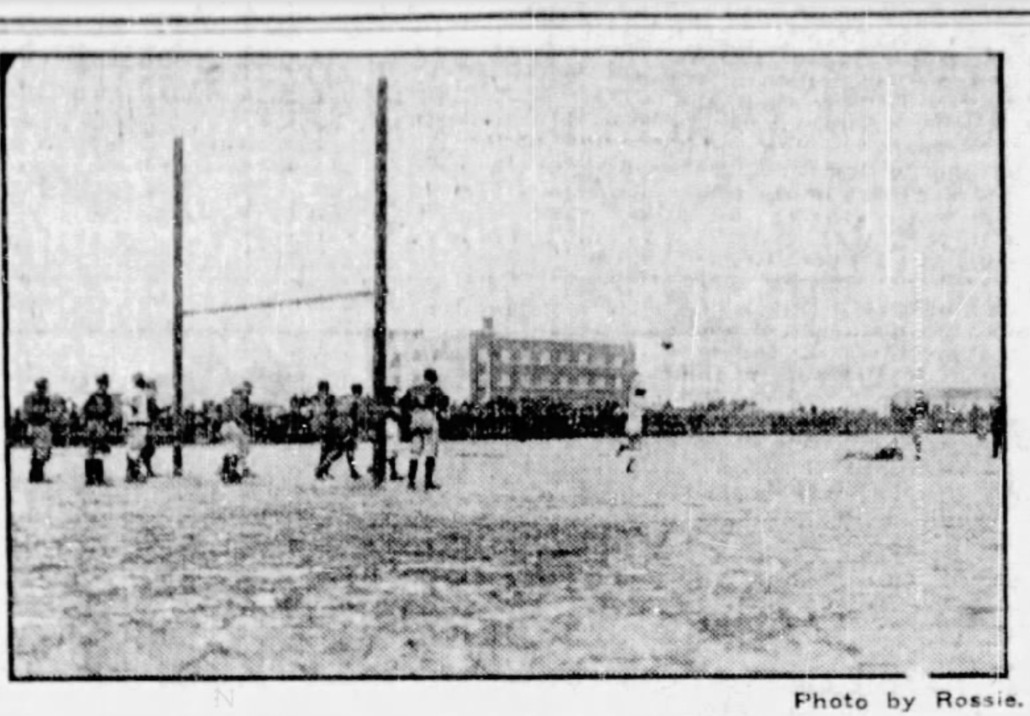Rugby: Canadian Football’s English Origins

A convert kick during the Regina Rugby Club’s western championship game vs. the Winnipeg Rowing Club at Regina’s Dominion Park on November 15, 1913. Photo from the November 17, 1913 edition of the Morning Leader newspaper.
By Tom Fuzesy
Football as we know it as today was heavily influenced by the game of rugby and was known as “rugby” or “rugby football” well into the 1950s. This game has a long, vibrant history in Saskatchewan, predating the creation of the Regina Rugby Club and even the province itself. The origin of the Saskatchewan Roughriders can be traced back to the formation of the Regina Rugby Club in 1910, which, with the Moose Jaw Tigers, formed a two-team rugby league.
Rugby was introduced to Canada through early British newcomers who continued to play the game in their new country. The first recorded game played in Regina was in the 1880s, when the city was still part of the Northwest Territories. The North-West Mounted Police (NWMP) often played at the barracks. Over time, rugby unions with formal constitutions and bylaws were established, and in 1891 a true competition with crowned champions began. Through the 1890s, teams from Winnipeg, Moosomin, and the NWMP were among the victors in prairie tournaments.
The popularity of rugby continued to grow. In 1895, the NWMP team travelled to Calgary to play an exhibition match against a local team and came out victorious. The following year a Manitoba — N.W.T. rugby union was formed after a meeting in Regina. Additional teams emerged in Regina with matches against the NWMP team. Despite this, in a few short years interest waned, and the community-based rugby teams declined. The sport was revived in 1907 with the formation of the Saskatchewan Rugby Football Union. This new group and league were made up of three teams: Regina City, Regina Civil Service, and the Moose Jaw Tigers. Railway Park was the location of Regina games—near the train station that is now Casino Regina.
In 1908, a new Regina team joined the league, the YMCA. The fan base was enough to warrant chartering a train to Moose Jaw for their game. The price of a round-trip ticket to Moose Jaw was $1.20 (approximately $30.00 today), which rose by a nickel to $1.25 two years later when the Regina Rugby Club made the same trip for their first-ever game.
Plans were made for a new rugby league in 1909, but instead a new baseball stadium, Dominion Park, was built on the west side of Broad Street. The next year, the Regina Rugby Club formed and used Dominion Park as its home field.
In the earliest days of rugby in Canada, the rules were very similar to traditional English rugby rules of the time. By the end of the 1890s, this was changing. University of Toronto Football captain, John Thrift Meldrum Burnside, came up with a list of rule changes known as the Burnside Rules. These rules brought Canadian rugby more in line with the rules governing the American game. Some of the changes included teams needing 3 tries (downs) to get 10 yards, a reduction of the number of players from 15 or 14 down to 12, and the introduction of the “snap back” way of scrimmaging the ball, rather than the throw-in or “heeling” of the ball that was done with the traditional rules.
The implementation of these new rules in Canada were inconsistent and haphazard at best. Some leagues fully incorporated them, some did only partially, and others stuck steadfastly with the original rules. Games between teams from different leagues sometimes had to play with one set of rules in the first half of the game before switching to a different set of rules in the second half.
In Saskatchewan, partial implementation of the Burnside Rules took effect in 1907. They used the 3 downs for 10-yards system, while maintaining the traditional rugby style of scrimmaging the ball and fielding 14 players on each side. Notably, two positions on the 14-player roster were scrimmagers, crucial for rugby-style scrimmaging. When moving to a snap back way of scrimmaging (also known as a “scrum”), where the centre snaps the ball back to the quarterback, the two scrimmage positions became redundant, and the eventual reduction of player size from 14 to 12 was natural. This reduction occurred around 1920 in Canada.
Another major change was the 1929 introduction of the forward pass in western Canada. Football in the United States had been using the forward pass since 1906, so when the change was debated in Canada, many complained about the over-Americanization of the Canadian game. Ultimately, the dividing lines had been drawn: western Canada favoured the forward pass, while eastern Canada did not. The Regina Roughriders, who played with the forward pass in 1929 league play, could not use it in the Grey Cup because the game was played using eastern rules. Over time, the eastern teams gradually embraced the forward pass. Initially, the first few years were complex for both the east and west, with a multitude of rules dictating when the pass was permissible (e.g., not allowed on 3rd down, prohibited across the goal line, restricted within five yards of the line of scrimmage, etc.). These rules were eventually standardized for clarity, and by 1931, the forward pass became legal nationwide. Although the pass was only used sparingly at first, it was the first major move away from one of the most fundamental rules of traditional English rugby.
One of the last rugby rule holdovers was the valuing of touchdowns. In Canadian football today, a touchdown is worth six points, but until the mid-1950s, a touchdown was five points. As kickers became more skilled, it was deemed that kicking two field goals should be valued less than a converted touchdown. Once again, the traditionalists did not like the change, protesting that the game was moving away too much from the traditional form of play and being Americanized. Despite their objections, the change was implemented in 1956.
While modern Canadian football developed from many changes based on American sports, the Canadian Football Leage (CFL) still maintains some rules distinct from Americans, such as the number of downs (three, versus the NFL’s four) and field size (CFL fields are wider). For example, the Canadian football field is 35 feet wider than the American field, likely because Canada adheres more closely to the traditional rugby field dimensions than the United States.
In 1906, Americans were using up to three downs to make it 10 yards, resulting in many low-scoring, defensive games, partially due to the relatively narrow field they were playing on. They changed to four downs by 1912, making their game more offensive and higher scoring. In Canada, the three-down rule was kept because with a wider field, offences have more room to maneuver, resulting in more success moving the ball.
In many ways, the differences in rules between Canadian and American football can be partly attributed to Canadians’ ever-present attachment to traditional rugby rules, perhaps reflecting our ongoing status as a Commonwealth Nation. Since 1910, rugby-cum-football has only grown in popularity, especially in Saskatchewan who is known worldwide for its passionate, water-melon-hat-wearing football fans.
Tom Fuzesy is a volunteer for Heritage Regina and is an avid sports fan, researcher, and local historian.

Leave a Reply
Want to join the discussion?Feel free to contribute!